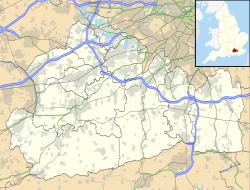The average level of accommodation in the region composed of detached houses was 28%, the average that was apartments was 22.6%.
The proportion of households in the civil parish who owned their home outright compares to the regional average of 35.1%. The proportion who owned their home with a loan compares to the regional average of 32.5%. The remaining % is made up of rented dwellings (plus a negligible % of households living rent-free).
Garden village expansion plan
In 2006, the owners of Dunsfold Park proposed the construction of a new town with 2,600 homes on the site, a school, health services, public transport and road links to the A281, and an expanded business district. [14] One of the largest construction projects in Surrey, it would result in the closure and replacement of the aerodrome. The project resulted in the formation of the STOP Dunsfold Park New Town campaign.
In late 2007, Dunsfold Park Ltd. applied to have their plans for the new town selected as one of the Brown Ministry's proposed "eco-towns". On 3 April 2008 Dunsfold Park was denied Eco-town status by Housing Minister, Caroline Flint. According to the Government's press release over 40 applications including Dunsfold Park were rejected "for being undeliverable or not ambitious enough to meet the high environmental and affordability standards set by Government."
An appeal in 2009 was rejected by the then Secretary of State John Denham. His conclusions included remarks on the sustainability of the site that [15] "The Secretary of State has concluded that the development would generate a considerable amount of additional road traffic and he considers that this would have a severe and unacceptable impact on an overstretched local road network, and that the scheme would be unsustainable in transport terms."
In March 2018, the Secretary of State granted planning permission for 1,800 homes and a school on the site, the first phase in a plan to provide around 2,600 new homes. [16]




